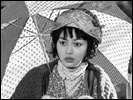Princess in an Iron Helmet
- Year
- 2006
- Original title
- Korogare! Tamako
- Japanese title
- 転がれ!たま子
- Director
- Cast
- Running time
- 103 minutes
- Published
- 29 September 2006



by Tom Mes
When Kaze Shindo's debut film Love/Juice arrived on the scene in 2000, people sat up to take notice. Not only was the director the granddaughter of the venerable Kaneto Shindo, her film was a naturalistically-shot and very likeable lesbian-tinged love triangle told with a good deal of imagination. Love/Juice was selected for the Berlin Film Festival's Forum section, won a prize, did the rounds of foreign fests, and received almost unanimous reviews. The arrival of a female director with a voice, in a country and at a time when these could be counted on the fingers of one hand, led many to believe that Shindo was destined for greatness. The enthusiasm proved to be premature. Aside from an entry in the, for the most part disposable, Cop Festival (Deka Matsuri) series of home-made shorts, nothing more was heard from her.
That she re-emerges only now is surprising on the one hand - what took her so long? - but not at all on the other. After the success of such films as Kamikaze Girls, Nana and Linda Linda Linda, which all revolved around very similar ingredients to the ones that made Shindo's debut so effective, it was only a matter of time before someone asked her to helm something in the same vein.
Princess in an Iron Helmet tells the tale of twenty-year-old Tamako (Yamada), daughter of a layabout artist (the ubiquitous and irrepressible Takenaka) and the owner of a beauty salon (Kishimoto), who suffers from a female equivalent of Peter Pan-syndrome. Permanently decked out in florid frocks and the titular helmet that her estranged father once made her, she eats nothing but muffins from the local bakery, rarely speaks a word, and lives in a fantasy world of her own making.
For about 50 minutes, that's all there is to Princess in an Iron Helmet. In a film without much narrative drive, we are taken from one little episode to the next, all relying heavily on a cast of colourful and quirky supporting characters, and above all on frequent close-ups of Yamada's undeniably cute face to keep the viewer amused. The mental inertia of the protagonist is equalled by the lack of drive to the script. The film is not devoid of charm, in a sub-Amélie sort of way, and the lead actress can purse her lips quite convincingly, but her character grows stale quickly, giving the viewer the urge to give her a good kick up the backside. Long before Tamako finally realises it, we've been yelling at her to grow up, for god's sake, get a life, look a little further than the three blocks surrounding your mom's house. It's an interruption of her daily supply of muffins that finally forces her to enter real life, at which point the film either improves or deteriorates, depending on how susceptible you've been to all the infantilism.
Tamako is a dreamy figure, ironically much closer to the kind of characters that populate fluff of the Shunji Iwai variety than to the young women in the films that seem to have helped greenlight Princess in an Iron Helmet. Linda Linda Linda was a film whose views of growing up resonated because they were culled from life instead of the pages of a shojo manga or an attempt to transpose Amélie Poulain to the suburbs of Tokyo. But it was no less imaginative and entertaining for it.
Perhaps all its producers aimed to do was pitch Princess in an Iron Helmet at the teenage Harajuku crowd, with their equally narrow world view of boutiques and fast food restaurants on the few square kilometres between Shibuya and Ikebukuro. A newspaper subscription would strike me as a more urgent measure. As for Kaze Shindo, who knows what's required to get her to fulfil the promise of that now disparagingly distant debut.